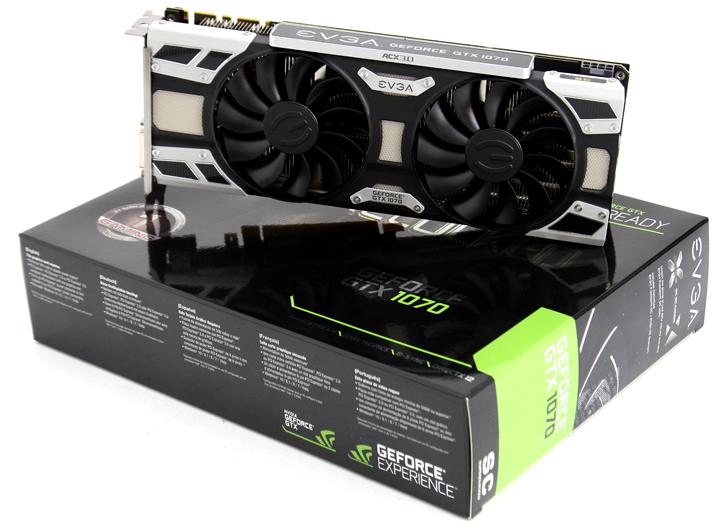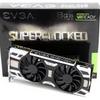Introduction
EVGA GeForce GTX 1070 SuperClocked GAMING ACX 3.0
Say Hello To My Little Friend !
In today's review we'll be zooming in at the new EVGA Superclocked Gaming edition of the GeForce GTX 1070. The SC (short for SuperClocked) editions are factory tweaked and cooled better. The GTX 1070 SC GAMING as tested today comes with a rather cool ACX revision 3.0 cooler. The 1070 has been a hit ever since the its release a coupld of weeks ago. Crazy stuff, and that is testimony to the fact that you guys have been waiting very long on the new graphics cards from both AMD and Nvidia. It's for good reason, the graphics card industry, or the GPU industry has been on hold, waiting for a smaller GPU fabrication process to become viable. Last generation GPUs were based on a 28 nm fabrication, an intermediate move to 20 nm was supposed to be the answer for today’s GPUs, but it was a problematic technology. Aside from some smaller ASICs the 20 nm node has been a fail. Therefore the industry had to wait until an ever newer and smaller fabrication process was available in order to shrink the die which allows for less voltage usage in the chips, less transistor gate leakage and, obviously, more transistors in a GPU. The answer was to be found in the recent 14/15/16 nm fabrication processors and processes with the now all too familiar FinFET + VLSI technology (basically wings on a transistor). Intel has been using it for a while, and now both Nvidia and AMD are moving towards such nodes as well. Nvidia is the first to announce their new products based on a TSMC 16 nm process fab by introducing Pascal GPU architecture, named after the mathematician much like Kepler, Maxwell and Fermi. That stage has now passed, the GeForce GTX 1070 and 1080 have been announced with the 1080 slowly becoming available in stores as we speak, the 1070 cards you'll start to see selling by next week (June 10th 2016). Both cards are equally impressive in it's product positioning, though I do feel the 1070 will be the more attractive product due to it's price level, the 1080 cards really is what everybody want (but perhaps can't afford). The good news though is that the board partner cards will sell for less opposed to the Nvidia reference / Founder edition cars. Obviously the higher-end all customized SKUs will likely level with that founders edition card price level again, but I am pretty certain you'd rather spend your money on a fully customized AIB card that is already factory tweaked a bit opposed the the reference one.
In this review we look at the EVGA GeForce GTX 1070 ACX 3.0 fitted with a high-end Pascal GP104 based GPU. A product series that is to replace the GeForce GTX 980. The EVGA PCB comesd with 5 power phases much like the reference PCB, it has a nice dark aesthetic feel and comes with the new revised ACX cooler. The GeForce GTX 1070 is all about that Pascal GP104 GPU, yet for obvious reasons had to be slowed down a bit opposed to the 1080. The GeForce GTX 1070 might have the same GP104 GPU housed on it's PCB as that 1080, however it is a cut-down version of the GPU as Nvidia stripped away some segments. Where the GeForce GTX 1080 has 2560 shader processors, the GeForce GTX 1070 has 1920 shader processors. This means it is has 15 out of the 20 SMs active (15 streaming multi-processors x 128 shader cores). In order of magnitude, the secondary biggest change is the memory type being "regular GDDR5" memory and not the new and hip GDDR5X. That memory is clocked at 2,000 MHz which is 8 GHz (GDDR5-effective) at a memory bandwidth of 256 GB/s. The two differences are responsible for a performance drop from 9 TFLOP/s Single-precision floating point performance for the GeForce GTX 1080 towards 6.45 TFLOP/s for the GeForce GTX 1070. You will have noticed that EVGA has released many SKUs based on the 1070 including a founders edition, an more regular ACX 3.0 version, then the SC Gaming edition and even a Gaming FTW edition.
The SC Gaming ACX 3.0 version comes with faster clocks and improved cooling perf, the airflow is improved whilst remaining silent. Up-to 60 Degrees C the card will even stay in passive mode, e.g. the fans will not spin and thus remains in-audible. At the backside you'll spot a nice matte black solid backplate. The EVGA GeForce GTX 1070 SC GAMING is locked and loaded with clock frequencies of 1785 MHz (boost) / 1595 (base), so straight out of the box the product already is clocked as notch higher for you. Right, we have enough to talk about and to show, let's head on-wards in the review. We'll start with a product overview in the photo-shoot.

EVGA GeForce GTX 1070 SuperClocked Gaming with the Nvidia GP104 GPU ( 1595 MHz core / 1785 MHz boost / 8008 MHz memory )

